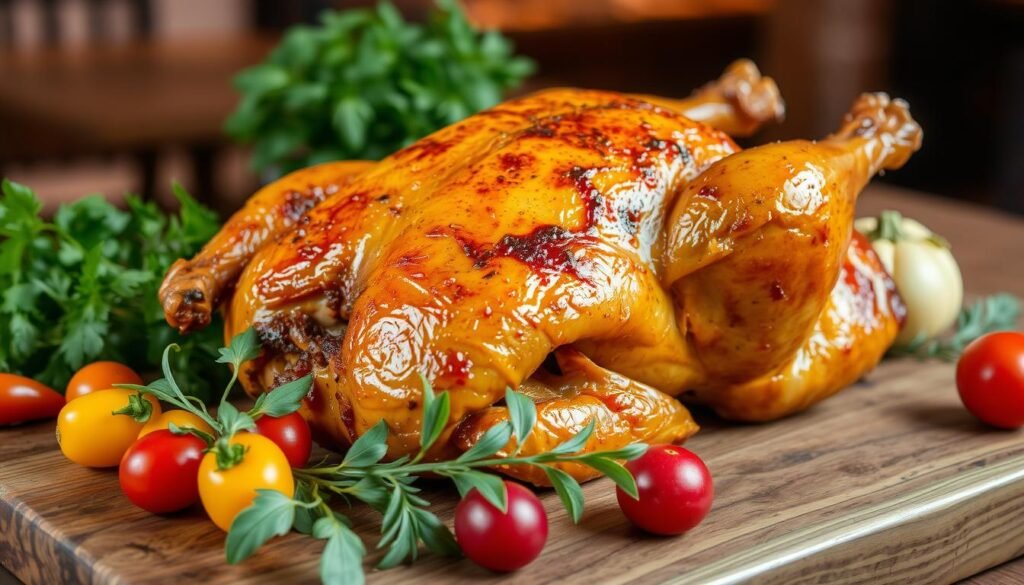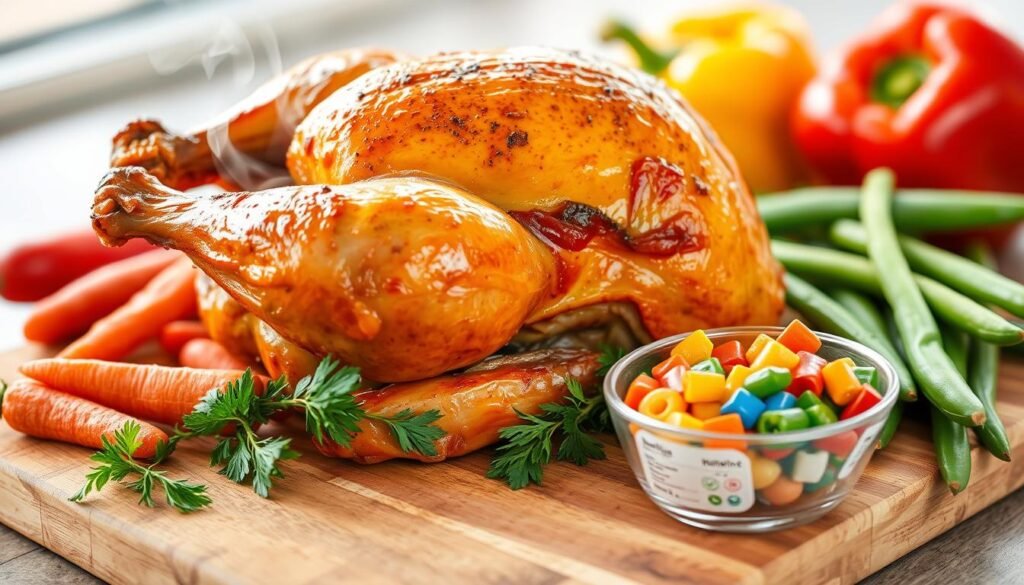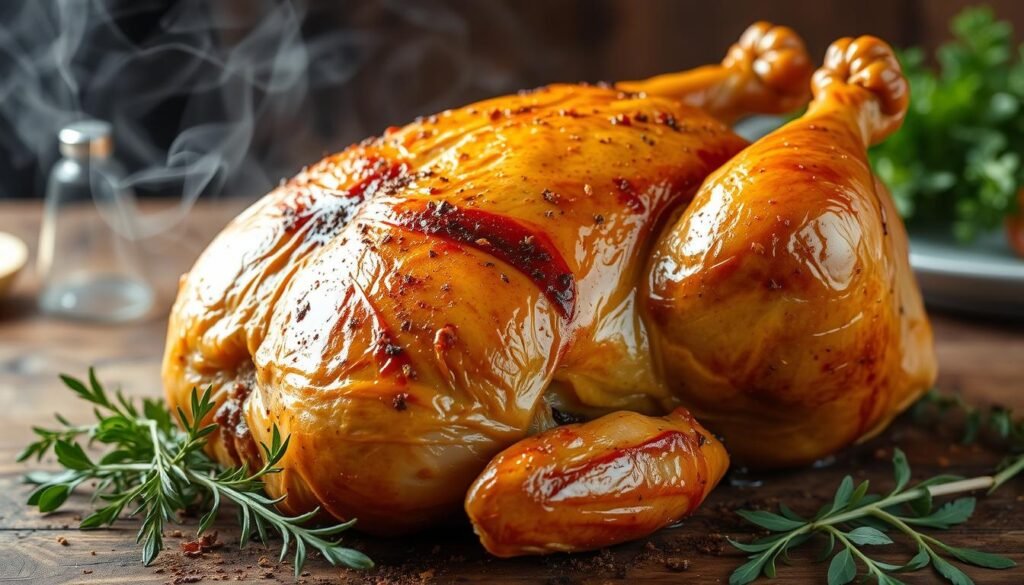Ever thought about the healthiness of that tasty rotisserie chicken from the store? Its golden skin and yummy smell make it seem like a good choice. But, the truth is, its calorie and nutrient content can change a lot. This depends on the meat cut, if you eat the skin, and the seasonings used.
Key Takeaways
- Rotisserie chicken can provide a wide range of calorie and nutrient values depending on the specific cut and preparation.
- Removing the skin can significantly reduce the calorie and fat content of rotisserie chicken.
- Rotisserie chicken is a convenient and affordable option, but store-bought versions may contain additional seasonings and additives.
- Oven-roasted rotisserie chicken is a healthier alternative to fried chicken, but monitoring portion sizes is still important.
- Rotisserie chicken can be a nutritious choice due to its protein, vitamin, and mineral content, but understanding the nutritional profile is key.
Introduction to Rotisserie Chicken
Rotisserie chicken is a favorite in many American homes. It’s a pre-cooked, seasoned whole chicken that’s easy and affordable. This cooking method makes the chicken’s skin crisp and flavorful.
Convenience and Affordability
Rotisserie chickens are easy to find at grocery stores. They’re cheaper than buying and cooking a whole chicken yourself. This makes them a great choice for busy people or families.
Oven-Roasted Cooking Method
The chicken is cooked slowly while being rotated over heat. This ensures it’s cooked evenly. The rotation also makes the chicken juicy and the skin golden.

Rotisserie chicken is a healthy and tasty meal option. Its unique cooking method makes it juicy and flavorful. It’s perfect on its own or in many different dishes.
Rotisserie Chicken Nutrition Facts
Rotisserie chicken is a nutritious and popular choice for many households. It’s high in protein and provides a significant amount of several essential vitamins and minerals. The exact nutrient content can vary depending on the specific cut of meat and whether the skin is consumed.
Calorie and Macronutrient Breakdown
A 3-ounce serving of rotisserie chicken (without the skin) can contain anywhere from 122 to 192 calories, depending on the cut. The thigh meat typically has 165 calories, while the breast meat has 122 calories per 3-ounce serving. In terms of macronutrients, a 3-ounce serving provides 21 to 24 grams of protein, 3 to 9 grams of fat, and negligible amounts of carbohydrates.
Vitamins and Minerals
Rotisserie chicken is an excellent source of several important vitamins and minerals. A 3-ounce serving can provide the following percentages of the Daily Value (DV):
- Niacin: 30-51% DV
- Riboflavin: 9-15% DV
- Vitamin B12: 10-15% DV
- Phosphorus: 15-17% DV
- Selenium: 36% DV
- Zinc: 7-15% DV
Rotisserie chicken is also a good source of other nutrients, such as iron and potassium.

With its impressive nutrient profile and affordability, it’s no wonder that rotisserie chicken has become a staple in many households. Whether you choose the thigh or breast meat, you can enjoy the convenience and flavor of this versatile protein-packed option.
rotisserie chicken calories
Many people wonder about the calories in rotisserie chicken. It’s a favorite for its ease and cost. Knowing its calorie and nutrient content is key.
A whole rotisserie chicken, about 695 grams, has around 1,190 calories. The calorie and fat count can change based on the meat cut and if the skin is eaten. The skin adds more calories and fat.
| Serving Size | Calories | Fat (g) | Protein (g) |
|---|---|---|---|
| 1 oz boneless, cooked | 67 | 3.6 | 9.3 |
| 1 small piece (yield after cooking, bone removed) | 76 | 3.8 | 11.4 |
| 1 medium piece (yield after cooking, bone removed) | 147 | 7.4 | 22.0 |
| 1 large piece (yield after cooking, bone removed) | 232 | 11.6 | 34.8 |
| 100g | 237 | 11.8 | 35.5 |
| 1 cup cooked, diced | 320 | 16.0 | 48.0 |
The calorie and nutrient content can vary based on the meat cut and skin consumption. Opting for leaner white meat and skipping the skin lowers calories and saturated fat.
Knowing the rotisserie chicken calorie counts and rotisserie chicken calorie breakdown helps you make better choices. This way, you can enjoy rotisserie chicken in a healthier way.
Ingredients in Store-Bought Rotisserie Chickens
Store-bought rotisserie chickens have more than just spices. They often include maltodextrin, sodium phosphates, and natural flavors in their seasoning. Some chickens are also marinated in solutions to keep the meat fresh and prevent bacteria.
Worried about these additives? You can skip most of them by not eating the chicken skin. The skin soaks up more of the seasonings and preservatives. The meat, on the other hand, is generally healthier.
Seasoning Blends and Additives
Check the ingredient list of your rotisserie chicken next time. You might be shocked to see maltodextrin, sodium phosphates, and natural flavors in the mix. These ingredients help with flavor and shelf life.
| Ingredient | Purpose |
|---|---|
| Maltodextrin | A carbohydrate used as a thickener, sweetener, and flavor enhancer. |
| Sodium Phosphates | Added to help retain moisture and improve texture. |
| Natural Flavors | Derived from natural sources to provide additional flavor profiles. |
Some rotisserie chickens are marinated before cooking. This keeps the meat fresh and prevents bacteria. But, it can also make the chicken higher in sodium.
“If you have concerns about these additives, you can avoid most of them by not eating the skin.”
Benefits of Choosing Rotisserie Chicken
Rotisserie chicken is a great choice for many reasons. It’s not just good for you, but also easy to use in many meals. It’s perfect for those on a low-carb diet or just looking for a quick, healthy meal.
Rotisserie chicken is also very affordable. It costs less than many other ready-to-eat chicken options. This makes it a great choice for those who want a nutritious, yet budget-friendly, protein source.
Another big plus is how convenient it is. The chicken is already cooked, so you can just grab it and go. Or, you can easily add it to many meals with little prep work. It’s perfect for busy days or when you need a fast, filling meal.
Plus, rotisserie chicken is a healthier option than fried chicken. It’s oven-roasted, which means it has fewer calories and less fat. This makes it a great choice for those following a low-carb diet.
In summary, choosing rotisserie chicken has many benefits. It’s convenient, affordable, and healthier than other chicken options. It’s a great choice for saving time, money, or calories, helping you reach your dietary goals.
Potential Downsides of Rotisserie Chicken
Rotisserie chicken is loved for its ease and affordability. Yet, there are some downsides to know. Some store-bought rotisserie chickens have phosphate additives. Studies show these additives might lead to bone loss over time.
But, chicken and other proteins naturally have more phosphorus than these additives. For most, rotisserie chicken phosphorus isn’t a big worry. Yet, those with chronic kidney disease should watch their phosphorus intake, as advised by their doctor.
Phosphate Additives and Bone Health
Some research links too much phosphate, especially from processed foods, to bone loss and osteoporosis. High phosphate levels can upset the body’s calcium-phosphorus balance. This might cause bones to lose calcium.
Still, the link between rotisserie chicken phosphates and bone health is not clear. Most people eat a balanced diet with enough calcium and nutrients for strong bones. If you don’t only eat rotisserie chicken, the phosphate additives are unlikely to harm your bones.
The rotisserie chicken phosphates issue is just one thing to think about. Rotisserie chicken can be a good choice, especially with fresh, whole food sides. Remember, moderation and knowing your dietary needs are key to a healthy diet.
Is Rotisserie Chicken Healthy?
Rotisserie chicken is a popular and convenient meal option. But, there’s a debate about its healthiness. The good news is that rotisserie chicken can be healthy if you make smart choices.
Chicken is a great source of lean protein. This is important for building and keeping muscle. A 3-ounce serving of rotisserie chicken breast without skin has 122 calories and 24 grams of protein. This makes it a nutritious choice. The thigh with skin, however, has 192 calories in a 3-ounce serving.
Store-bought rotisserie chickens may have added seasonings and preservatives. But, you can avoid this by removing the skin before eating. Organic rotisserie chickens are also available. They are fed higher-quality feed and might be a healthier choice.
Rotisserie chicken is a quick and easy way to add protein to your meals. A 3-ounce serving of rotisserie chicken breast provides 24g of protein, making it great for salads, wraps, or chili. Pairing it with fresh vegetables and whole grains makes for a balanced and nutritious meal.
| Rotisserie Chicken Part | Calories (per 3 oz serving) | Protein (grams) | Fat (grams) | Sodium (mg) |
|---|---|---|---|---|
| Breast without skin | 122 | 24 | 3 | 83.3 |
| Thigh with skin | 192 | 19 | 13 | 285 |
| Wing with skin | 216 | 20.2 | 14.4 | 83.3 |
In conclusion, rotisserie chicken can be a healthy and convenient option when eaten in moderation. Choose leaner cuts, avoid the skin, and pair it with nutritious sides. This way, you can enjoy the benefits of this versatile protein-rich meal.
Choosing Lean or Skin-On Portions
Deciding between lean meat and skin-on portions is key when enjoying a rotisserie chicken. The calorie and fat content changes a lot based on this choice.
The Skinny on Rotisserie Chicken Skin
The crispy skin of a rotisserie chicken is delicious but high in saturated fat. Removing the skin halves the saturated fat in breast meat and reduces it by a third in dark meat. For those watching their fat and calorie intake, it’s best to avoid the skin and choose lean, skinless parts.
| Chicken Cut | Calories (Skin-On) | Calories (Skinless) | Saturated Fat (Skin-On) | Saturated Fat (Skinless) |
|---|---|---|---|---|
| Breast | 197 | 165 | 2.3g | 1.1g |
| Thigh | 229 | 209 | 3.9g | 2.6g |
| Drumstick | 216 | 175 | 2.8g | 1.4g |
| Wing | 290 | 203 | 4.9g | 2g |
The table shows that skin-on portions have more calories and saturated fat than skinless ones. For those looking to reduce rotisserie chicken skin and rotisserie chicken fat, lean, skinless cuts are better.
While the skin is tempting, it’s best to avoid it because of its high saturated fat content. This can raise the risk of heart disease. For a healthier option, choose the lean, skinless parts of the rotisserie chicken.
Sodium Levels in Rotisserie Chicken
Rotisserie chicken’s sodium content can vary a lot. Some are brined in salt before cooking, while others use salty seasonings. This makes it key to watch your sodium intake.
A 3-ounce serving of rotisserie chicken can have over 600 milligrams of sodium. This is a lot, especially since the American Heart Association suggests no more than 2,300 milligrams a day. In fact, one serving can be up to 35% of your daily limit.
Too much sodium can raise blood pressure, a big problem in the U.S. If you’re watching your sodium, look for lower-sodium rotisserie chickens. Or, make your own at home to control the salt.
| Nutrient | Amount per 3-ounce Serving | % Daily Value |
|---|---|---|
| Sodium | 518.8 mg | 35% |
| Total Fat | 10.9 g | – |
| Saturated Fat | 3.2 g | – |
| Protein | 11.8 g | – |
| Niacin (B3) | – | 35% |
| Riboflavin (B2) | – | 15% |
| Pantothenic Acid (B5) | – | 15% |
The sodium in rotisserie chicken can differ based on the chicken you pick. If you’re worried about rotisserie chicken sodium, choose lower-sodium options. Or, make your own high sodium rotisserie chicken at home.
Using Rotisserie Chicken in Meals
Rotisserie chicken is a versatile and time-saving protein. It can be used in many delicious recipes. You can enjoy it on its own or add it to soups, casseroles, salads, or sandwiches.
To make meals balanced and nutritious, pair rotisserie chicken with fresh veggies, whole grains, and healthy fats. This ensures you get all the essential vitamins, minerals, and macronutrients.
Rotisserie Chicken Meal Ideas
- Sweet and Spicy Chicken Rice Bowls – Each serving provides approximately 41g of protein, 11g of fat, and 68g of carbohydrates.
- Pressed Chicken Pesto Sandwich – Contains around 49g of protein, 21g of fat, and 53g of carbohydrates per serving.
- Easy Chicken Enchiladas – A serving includes about 48g of protein, 21g of fat, and 75g of carbohydrates.
- Balsamic Chicken Grain Bowl – Offers approximately 44g of protein, 18g of fat, and 49g of carbohydrates per serving.
- Sweet Honey Mustard Chicken Salad – Each serving has about 38g of protein, 14g of fat, and 37g of carbohydrates.
Rotisserie chicken’s versatility lets you tailor meals to your taste and dietary needs. You can separate white and dark meat for better control over protein and fat.
Using rotisserie chicken in your cooking makes meal prep easier. It allows you to enjoy tasty, nutritious dishes without overcomplicating nutrition.
| Dish | Protein (g) | Fat (g) | Carbohydrates (g) |
|---|---|---|---|
| Sweet and Spicy Chicken Rice Bowls | 41 | 11 | 68 |
| Pressed Chicken Pesto Sandwich | 49 | 21 | 53 |
| Easy Chicken Enchiladas | 48 | 21 | 75 |
| Balsamic Chicken Grain Bowl | 44 | 18 | 49 |
| Sweet Honey Mustard Chicken Salad | 38 | 14 | 37 |
Tips for Selecting Rotisserie Chicken
Choosing the best rotisserie chicken involves several key factors. Look for nutrition information to ensure it’s healthy. Opt for a chicken without added solutions or excessive seasonings if you’re watching sodium.
Trusted brands and retailers are often a good bet. Costco, for example, is famous for its affordable and tasty rotisserie chickens. In 2023, they sold 137 million chickens, up from 117 million the year before, all for just $4.99.
Look for chickens that are plump and evenly browned. A juicier chicken is usually heavier. Avoid chickens with split legs or too much juice in the container.
- Choose a chicken that fits your dietary needs and preferences
- Opt for options with transparent nutrition information
- Select a chicken from a trusted brand or retailer
- Look for signs of juiciness, such as a plump, evenly browned appearance
- Avoid chickens with excess pooled juice or split chicken legs
The best rotisserie chicken is one that tastes good and meets your health goals. By following these tips, you can find a delicious and satisfying chicken.
| Statistic | Value |
|---|---|
| Costco Rotisserie Chicken Sales | 137 million in 2023, up from 117 million in 2022 |
| Costco Rotisserie Chicken Price | $4.99 |
| Costco Rotisserie Chicken Shelf Life | 2 hours before repurposing |
“Costco’s rotisserie chicken is priced at a surprisingly low cost of just $4.99, which has remained constant for over a decade despite price increases in other grocery staples.”
Conclusion
Rotisserie chicken is a great choice for a quick and healthy meal. It’s full of protein and important vitamins and minerals. By picking leaner white meat and skipping the skin, it can be even healthier.
The rotisserie chicken nutrition summary shows that its nutritional value can change. This depends on the meat cut, whether you eat the skin, and the seasonings used.
Rotisserie chicken health benefits include being easy to find, affordable, and packed with protein. Eating it in moderation and choosing the right ingredients can make it a smart choice for your diet. Remember to watch your portion sizes and avoid too much sodium or fat.
In the end, rotisserie chicken can be a great part of a healthy diet. Just be smart about what you choose and how much you eat. Knowing the rotisserie chicken nutrition summary helps you enjoy its benefits without overdoing it.



